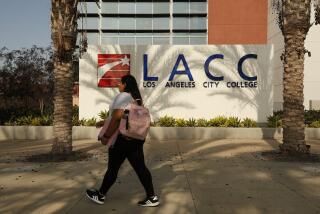Task force moves toward rationing access to community colleges
Jasmine Delgado is one of the lucky ones. With advice from an older sister, the Santa Monica College student developed a plan that has helped her enroll in the classes she needs to transfer next year to a four-year university.
But many California community college students lack the motivation, guidance and resources to reach that goal. So, for the past year, a statewide task force has been studying ways to help them get there.
The panel held its first town hall meeting this week at the L.A. Area Chamber of Commerce, attracting a packed audience of educators, community members and students who were given an overview and the chance to comment on draft recommendations that will be presented to the California Community Colleges’ Board of Governors.
The proposals are for sweeping reforms that would move toward rationing access to community colleges, compel students to take more responsibility for their education and prioritize the types of classes being offered.
Under the state’s Master Plan for Higher Education, community colleges have long offered an open door for anyone who sought to benefit. But the task force suggests that after years of state funding cuts, community colleges can no longer be all things to all people.
“To participate fully in education without accountability is a wonderful ideal, but that’s not the reality we’re in,” said task force chairman Peter MacDougall, a member of the colleges’ board. “How do we use our limited resources? There have to be priorities and there has to be focusing.”
The 22 recommendations seek to “reboot” the system by prioritizing registration and fee waivers for students who participate in assessment and orientation programs, and who have concrete goals, such as a degree, certificate or to transfer to a four-year college. The panel estimates that tightening the criteria for fee waivers could save about $89 million annually, which could fund new support services.
Course offerings and schedules would be aligned to students’ needs, including focusing on basic skills and classes needed to transfer. More authority would be given to the California Community Colleges chancellor to implement reforms over the state’s 72 college districts and 112 colleges.
Campuses would be required to publish a score card, detailing their performance in such areas as completion rates.
Reaction to the effort was mixed at Thursday’s town hall.
“If students have access but are never going to get anything out of it, I don’t think we should be applauding that,” said Michele Siqueiros, executive director of the nonprofit Campaign for College Opportunity. She said her group will use its resources to support the measures.
The Faculty Assn. of California Community Colleges said it has not yet developed a formal response to the report.
For students like Nick Avetisian, the greatest need is for more class offerings.
“There might be 40 students already registered and 100 more trying to add,” said Avetisian, 20, a Los Angeles City College student studying finance. “I think the score card is a good idea and would help you figure out what kind of school you’re going to.”
Delgado, 18, vice president of student government at the Santa Monica campus, said she hopes the panel will get more student input before presenting its recommendations. She is particularly concerned that campuses maintain access for low-income and other disadvantaged students.
“The points they raise are relevant but there are a lot of policies restricting the kind of access we have now,” she said.
More to Read
Start your day right
Sign up for Essential California for news, features and recommendations from the L.A. Times and beyond in your inbox six days a week.
You may occasionally receive promotional content from the Los Angeles Times.






